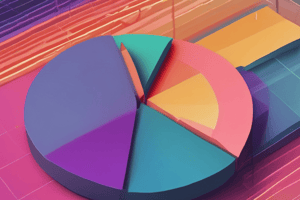Podcast
Questions and Answers
What type of graph has bars that are of uniform width and are evenly spaced with gaps between the bars?
What type of graph has bars that are of uniform width and are evenly spaced with gaps between the bars?
- Circle Graph
- Bar Graph (correct)
- Histogram
- Pictograph
Which graph shows frequencies of data values in intervals of the same size?
Which graph shows frequencies of data values in intervals of the same size?
- Bar Graph
- Frequency Table
- Histogram (correct)
- Dotplot
What is the formula used in a frequency histogram to express class frequency?
What is the formula used in a frequency histogram to express class frequency?
f/n
What type of graph uses proportional segments of a circle to represent total quantities?
What type of graph uses proportional segments of a circle to represent total quantities?
What does a Pareto Chart display?
What does a Pareto Chart display?
Which type of graph uses pictures instead of solid bars?
Which type of graph uses pictures instead of solid bars?
What is Quantitative Data?
What is Quantitative Data?
What does Exploratory Data Analysis (EDA) utilize to detect patterns in data?
What does Exploratory Data Analysis (EDA) utilize to detect patterns in data?
What defines an Outlier in a dataset?
What defines an Outlier in a dataset?
What is the purpose of a Frequency Table?
What is the purpose of a Frequency Table?
What do Class Boundaries represent?
What do Class Boundaries represent?
How can the Shape of Distribution be described?
How can the Shape of Distribution be described?
What does skewed distribution indicate?
What does skewed distribution indicate?
What is a relative frequency histogram?
What is a relative frequency histogram?
What is relative frequency?
What is relative frequency?
What does a midpoint represent in data?
What does a midpoint represent in data?
What is an ogive?
What is an ogive?
Flashcards are hidden until you start studying
Study Notes
Graphical Representations of Data
- Bar Graph: Displays categorical data using uniform-width bars with gaps between them.
- Histogram: Represents quantitative data with adjacent bars that show frequency distributions over intervals.
- Frequency Histogram: Illustrates the ratio of class frequency to total frequency, useful for relative understanding of data distribution.
- Circle Graph (Pie Chart): Divides total quantities into segments, each representing a part of the whole, typically used for qualitative data.
- Time Plot: A graph that organizes data points sequentially over time, making trends easier to identify.
- Pareto Chart: A specialized bar graph arranged from most to least frequent, highlighting the most significant factors in qualitative data.
- Pictograph: Uses images or symbols to represent data quantities rather than traditional bars.
Data Organization Techniques
- Stem-and-Leaf Display: Organized data display that retains original values, allowing for quick retrieval and analysis.
- Dotplots: Graphs that represent individual data points on a single axis, suitable for both categorical and quantitative data.
Types of Data
- Quantitative Data: Numerical values relevant to measurable quantities, such as times or distances.
- Qualitative Data: Non-numeric characteristics, like color or type, important for categorical analysis.
Data Analysis Concepts
- Exploratory Data Analysis (EDA): Utilizes various visual tools to identify data patterns and anomalies effectively.
- Outlier: A data point significantly different from others, which may suggest variability or error.
- Frequency Table: A structured list showing how often each data value appears within the dataset.
- Class Boundaries: Values defining the edges separating classes in frequency distribution, ensuring no gaps exist.
Data Distribution Characteristics
- Shape of Distribution: Describes data arrangement as normal, uniform, skewed (right or left), or bimodal, each indicating different statistical properties.
- Skewed Distribution: Features a peak on one side, indicating asymmetry where data clusters more heavily on one end.
- Relative Frequency Histogram: Similar to a regular frequency histogram but utilizes percentages to represent data relative to the whole instead of raw frequencies.
Additional Concepts
- Relative Frequency: The ratio of occurrence for an event compared to total trials, providing insight into event significance.
- Class Limit: Defines the highest and lowest bounds of a data class.
- Midpoints: The average of the upper and lower limits of a class interval, facilitating midpoint calculation and class interval size determination.
- Ogive: A line graph representing cumulative frequency or cumulative relative frequency, useful for understanding total distributions over intervals.
Studying That Suits You
Use AI to generate personalized quizzes and flashcards to suit your learning preferences.




